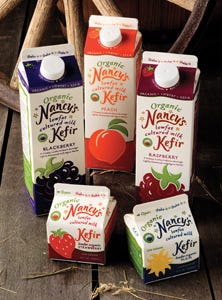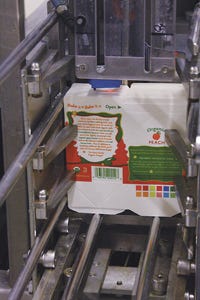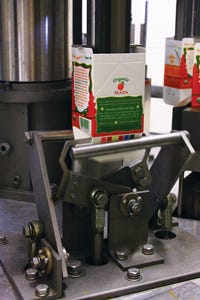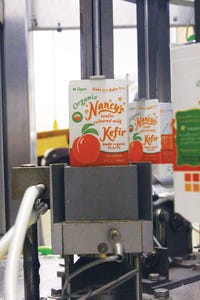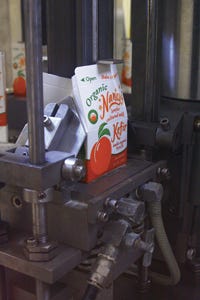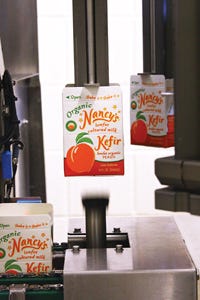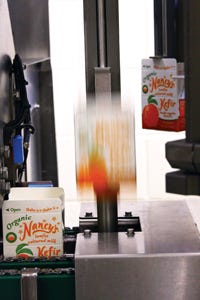Cultural evolution
January 30, 2014
|
The year was 1960, and Chuck Kesey and his wife, Sue, had recently graduated from Oregon State University, where Chuck studied dairy technology and Sue had taken business science classes. With the help of Chuck's father Fred Kesey, who founded and managed the Eugene Farmers Creamery, the couple entered the packaging-and-distribution side of the dairy business by supplying 1-gal glass returnable jugs of milk to other creameries. The couple also supplied the Springfield, OR, schools with milk—hence, their dairy's name became Springfield Creamery.
Meanwhile the '60s counterculture, of which Chuck's brother Ken Kesey, was an active participant, continued to groove. In 1962, Viking Press published Ken's most well-known book One Flew Over the Cuckoo's Nest. In a review published on Feb. 16, 1962, Time magazine stated the book is “a roar of protest against middlebrow society's rules and the invisible rulers who enforce them.”
While much attention has been paid to the psychedelic nature of the 1960s, it's important to note that the natural food movement also was a huge part of this culture.
The woman behind the brand
In 1969, the couple found themselves in a transitional period: Chuck's father had passed away, the dairy industry was in flux and the natural food movement was at full speed. The Keseys knew they had to find their niche to survive.
The Keseys found their muse in Nancy Van Brasch Hamren, who was working as a bookkeeper at Springfield Creamery. Hamren had an affinity for natural foods and a yogurt recipe passed down from her grandmother.
Hamren and Chuck began working on perfecting her grandmother's yogurt recipe. The result was Honey yogurt, which Springfield Creamery says is the first yogurt sold by a U.S. creamery containing acidophilus cultures.
Springfield Creamery sold its Honey yogurt in glass canning jars and 5-gal buckets at Willamette People's Co-op and Porters Fine Foods in Eugene, OR. When the manager from Willamette People's Co-op called and asked for some of that “Nancy's yogurt,” the folks at Springfield Creamery realized a brand was born.
With a little help from our friends
According to Sue, an underground comic book route operated by a University of Oregon graduate named Gilbert Rosborne and his partner–musician Huey Lewis–was instrumental in expanding the brand into the Bay Area. She says the comic book shops were savvy enough to make the connections between Nancy's Yogurt, Springfield Creamery and her brother-in-law Ken.
The creamery got further attention in 1972, when the Grateful Dead performed the first of many concerts there. This all helped the Nancy's brand get on natural foods stores' shelves in Washington, Oregon and California.
More than just yogurt
The Nancy's product line now contains more than 80 products, including yogurt, cottage cheese, sour cream and kefir.
|
|
|
|
Like yogurt, kefir is a cultured-milk product. According to the National Center for Home Food Preservation, it is believed to have originated centuries ago in the Northern Caucasus Mountains.
|
A vacuum arm (above) rises to meet a bottom-formed-and sealed carton. The carton (below) is lowered to f/f/s machines track. |
|
Since its launch in 1975, Nancy's Kefir grew its fan base in the Northwest. Understanding that the European-style drink has a distinctive taste with sour notes and a breadlike aroma, the creamery decided to play it safe and keep kefir a regional product.
“We didn't market outside the Northwest at all,” says Sheryl Kesey Thompson, who along with her brother Kit Kesey, work with their parents at the creamery. “Kefir just was a beast unto its own, and it was a real small portion of our business at that point.”
When the Keseys began seeing the proliferation of single-serve dairy drinks in 2006, they re-examined the marketing strategy for Nancy's Kefir. “We felt like we have that in our little eight-oz kefir,” recalls Sheryl. “We've been making it for years.”
Packaged for travel
Before Springfield Creamery could bring Nancy's Kefir to a national, mainstream market, the packaging needed an update. The containers had to be more durable to withstand longer trips, and they needed an approachable yet sophisticated look.
Before the recent redesign, the packaging for Nancy's Kefir hadn't changed since 1975, when an employee literally created its handmade look with some art pens in the back of the creamery. “The nutritional label has been updated over the years, but the graphics have not been updated since kefir launched in 1975,” explains Sheryl. “It needed some love.”
The rest of the Nancy's line had received a packaging makeover in 2003. “We didn't redo our kefir at that point, because we were undecided about what sort of container to put it in,” says Sheryl. “So, we held off on kefir until it was relaunched in 2007 with a new recipe that's fully organic and the packaging redesign.
“When we finally decided to relaunch the kefir, there was a lot discussion about whether or not to go to a bottle,” Sheryl adds. The family eventually decided against using plastic bottles, citing that the product would end up looking like every other product on the shelf. The Keseys also were fond of the kefir's existing gabletop packaging that was being supplied by Tetra Pak (www.tetrapak.com).
After learning that Tetra Pak had new board options, the Keseys decided to keep the gabletop package but change the material. Nancy's Kefir container would now be made from FreshCoat board. Sheryl says the FreshCoat-board containers have helped Springfield Creamery reach a five-week shelf life for the kefir.
To update the kefir to the new Nancy's branding, Springfield Creamery worked with Flint Design Co. (www.flintdesignco.com), which successfully redesigned 84 stock-keeping units (SKUs) of other Nancy's products in 2003. Commending Flint Design Co., Sheryl says: “They did a nice job for us because they took all the natural, hand-done elements of that feel of the original packaging—that kind of organic, hand-done flow that we wanted to communicate. Flint Design Company did a nice job of communicating that on the packaging redesign.”
The new packaging includes messaging for consumers not already familiar with the company, the Kesey family or their products. Sheryl explains: “The opportunity to do the packaging redesign allowed us to bring messaging forth about kefir's health benefits, and about probiotics, our ingredients and who we are as a company. Because we are a pretty unique company with our longevity, and the fact that we were family-owned and operated all these years.”
In addition, the back panel of the redesigned carton also announces that the family-owned creamery recently has been certified as an organic manufacturer.
Upping productivity
Now that Springfield Creamery had new packaging for the national launch, the company needed to update its packaging production line to increase its productivity. Kit led the charge of looking for a new filler that would have the capacity for the kefir's new national market and a small footprint while being reliable and, as his sister puts it, “not breaking the bank.”
The Keseys bought a NiMCO (www.nimco.com) 380QLCP CAP-PAC® form/fill/seal (f/f/s) machine with a Cap-Pac spout applicator, which is capable of forming, filling and sealing gabletop cartons from 8 to 32 oz at speeds up to 2,400 cartons/hour. The stainless-steel-frame machine has indexing electric heaters; a variable-frequency, mechanical-drive system, PLC touchscreen controls, and inside-out rotary and Cap-Pac spout applicators.
Gabletop cartons enter the machine as flats and exit the machine as formed, filled and sealed cartons. To help ensure clean folds, the NiMCO 380QLCP folds the tops and bottoms of the cartons twice before filling and sealing. Cartons exit the f/f/s machine via a discharge track to be coded with a Videojet (www.videojet.com) 37E ink-jet printer.
Room to grow
The packaging line and container update has given Springfield Creamery room to grow its kefir distribution channels, which Sheryl believes will be easy to fill. “Our salespeople love to go out and talk about the kefir because it's such an easy sell,” she says. “All anybody has to do is taste it.”
More information is available: |
Flint Design Co., 503/ 295-1979, ext. 204, www.flintdesignco.com. |
NiMCO Corp., 815/459-4200. www.nimco.com. |
Tetra Pak Inc., 847/955-6000. www.tetrapak.com. |
Videojet Technologies Inc., 800/843-3610 . www.videojet.com. |
About the Author(s)
You May Also Like
